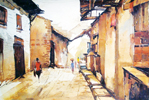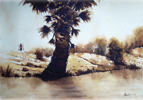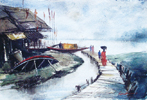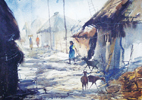About Some of his famous paintings

|
Suburban villas, highway-side retreats dread the encroachments of our growing streets, houses like tight boxes neatly squashed in the grimy and dingy rows of the city, blazing with all the July sun's collected rays. And the delighted citizen, who gasping there and breathing clouds of dust, and calls it country air are represented as a nowhere to be found reminiscence of the artist. The work Kolkata Goli, best shows the artist’s observant eye towards the city of joy, the peep he takes in the nooks and corners of the regal and majestic city. The encompassing loneliness that is distinguishing in the work of the artist gives us a resolute sentiment and sensation of sublime and awe. |

|
The artist does not only take us on a first to last voyage within the city, but tries to render the quintessence of the villages in the mysterious corners of Bengal. There is a way that nature speaks. Most of the time, we are simply not patient enough, quiet enough to pay attention to the story. The scheme of magnificence, sublime and nostalgia lurks in its corner too, and it is thus all the better proved in the work Loneliness. |

|
The calm river does attract us but at the same time inculcates within us a trepidation and fear. It is best in lieu to the sense of awe. The small figure of the villager is some what lost within the splendor and grandness of the overwhelming beauty of nature. At the very first glance Ranit’s works just strike a chord with the romantics taking a quick gaze into the villages of Bengal. Parallel emotions are fashioned out when one observes the work Ferry Ghat. |

|
We tend to translate the word ‘hero’ as having positive traits that are rather outstandingly valiant, alluring and charismatic qualities. However a person who is unseen in public eye but silently carving his own space by battling his struggle for life could be a hero too. Down the mean streets a man must go who is not himself mean, who is neither flawed or tarnished nor afraid. He is the hero, he is everything. Ranit takes a gaze at such people and celebrates them. Such is the Fishermen Series. |

|
His works emerge as a personal response to his immediate environment, the diversity of cultures and ecological transmutation in landscapes around him. These definitely enrich the range of representation and imagery in his work. The work Destination, besides glorifying the mundane people, also traces certain amount of nostalgia for rural Bengal. |

|
The subjects he used metaphorically in his painting are to epitomize the debarred that are still considered to be in bleak, desolate, helpless and struggling for survival. The artist’s proposal of the unscathed village life yet the unavailability of the material happiness are further more palpable in the work Village Life. |

|
Ranit, interestingly not only takes a look into the picturesque village and city lives, but also renders their beliefs and the refuge of their psyche and feelings. He in fact talks in a spiritual language to express his views. His work Shelter, best express the protection of the human mind and how the reliance and conviction in the idol of the goddess can actually be converted into or rather develop into a safe haven for people. |

|
Faith is raising the sail of our little boat until it is caught up in the soft winds above and picks up speed, not from anything within itself, but from the vast resources of the universe around us. Siddhi Data is the boy’s assurance in the Lord (Ganesha) that he is walking on the road and selling garlands used for worship. Faith isn't faith until it's all you're holding on to. |
Ranit Dutta’s landscapes and the people he portrays are non-specific, evoking a mood rather than a particular place, so that viewers are reminded of their own memories, dreams and nostalgia for locations because, we may forget what one has said, but we will never tend to forget how one can makes us feel.

